
Astronomers discover rare Einstein zig-zag lens formed by 2 galaxies
What's the story
According to their study published on arXiv, a team of international astronomers has made a groundbreaking discovery of an Einstein zig-zag lens in the universe. This unique phenomenon occurs when two galaxies align perfectly, resulting in their combined gravitational pull acting as a compound lens. The researchers describe this as "an extremely rare lensing configuration."
Light distortion
Unique light deflection observed in rare lensing configuration
The researchers detailed the unique light deflection process in this rare lensing configuration. They said, "Two out of the six multiple images are deflected in opposite directions as they pass the first lens galaxy on one side, and the second on the other side - the optical paths forming zig-zags between the two deflectors." This only further emphasizes the rarity and complexity of such a celestial alignment.
System analysis
Discovery of system J1721+8842 challenges initial assumptions
Initially, astronomers thought the system J1721+8842 was a single elliptical galaxy bending light from a quasar behind it. However, after two years of analyzing the data, variations in the quasar's image and duplicate light spots indicated otherwise. This is when they revealed this wasn't just one, but two galaxies acting as a compound lens - a finding that has major implications for our understanding of celestial bodies and their behaviors.
Hubble refinement
Compound lens discovery could refine Hubble constant calculations
The team hopes their discovery could help refine calculations of the Hubble constant, possibly putting an end to the ongoing debate about its true value. "We expect tight constraints on the Hubble constant and the equation of state of dark energy by combining these two probes on the same system," notes the study. Meaning, this unique celestial alignment could have far-reaching implications.